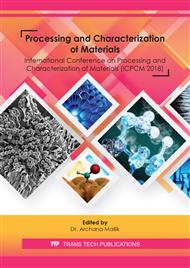p.183
p.191
p.202
p.209
p.216
p.222
p.229
p.237
p.245
Development of Hybrid Composites with Improved Heat Insulation Capability Using Short Human Hair Fiber
Abstract:
Human hair dumped in the waste streams as a waste material in most of the societies which creates many environmental problems, but it has many exceptional physical, mechanical and microstructural properties. The present investigation aims at developing a class of hybrid composite with improved insulation capabilities consisting of epoxy, short hair fibers (SHF), and solid glass microspheres (SGM). Solid glass microspheres (10 wt. %) filled epoxy based hybrid composites are fabricated with four distinct fiber loading (0, 5, 10, 15, 20 wt. %). Density and effective thermal conductivity of these composites are measured experimentally following appropriate ASTM standards. The measured effective thermal conductivities (Keff) are compared with theoretical values from “Rule of Mixture” model. It is noticed that thermal conductivity of the composite decreases with increase in fiber content. Micro-structural characterization such as scanning electron microscopy (SEM), X-ray diffraction (XRD) and Fourier-transform infrared spectroscopy (FTIR) analysis of the composite has been done to know the surface morphology, crystallinity and functional groups present in the composite. It is found that with the incorporation of 20 wt. % hair fiber along with 10 wt. % of SGM the thermal conductivity of the epoxy is reduced by about 27 %.
Info:
Periodical:
Pages:
216-221
Citation:
Online since:
February 2020
Authors:
Price:
Сopyright:
© 2020 Trans Tech Publications Ltd. All Rights Reserved
Share:
Citation:


